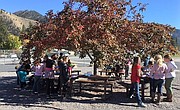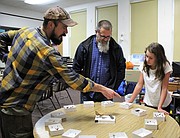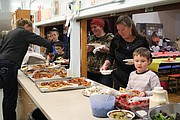'Lights On' Afterschool programs celebrate successes
Kathleen Woodford Mineral Independent | Hagadone News Network | UPDATED 8 years AGO
From learning how to sew a button onto a shirt to designing a spacesuit for NASA, afterschool programs across Mineral County offer a wide array of activities for students.
Oct. 26 was the official “Lights On” national celebration where afterschool events are held to showcase some of the projects students participate in and highlight program successes.
This year there was a lot to celebrate thanks to the support ofCongress, which voted in September to keep the lights burning after school. They increased funding for programs by $100 million in 2018.
“This vote is a resounding, meaningful victory for America’s children and families,” said Jodi Grant, Executive Director of the Afterschool Alliance in a statement earlier this fall.
Initially, President Trump’s budget proposal zeroed out federal funding for the afterschool and summer learning programs. Now the 21st Century Community Learning Centers have $1.1 billion, the level authorized in the Every Student Succeeds Act for the Fiscal Year 2018.
This year Montana received $1,167,839,540 to fund 52 programs across the state which serves over 5,800 children. Superior and Alberton received a joint five-year award for $108,000 per year in 2014. Funds support staff, supplies and field trips to students during the school year and summer programs.
On Nov. 7 and 8, the Superior program served chili during Parent-Teacher conferences along with games to celebrate “Lights on After School”. The Alberton program celebrated on Oct. 26 and hosted a dinner of pizza made by the students along with a showcase of several projects including demonstrations of yoga and bug collections.
Jessica Maurer, Alberton’s program director, traveled to the National 21st Century Community Learning Centers Summer Institute in Philadelphia, Penn. last July. During the conference she was able to meet with other program coordinators and share struggles as well as successes.
“Meeting all those different people from around the country striving for the same thing made me realize that we are not in this alone. It was a pretty powerful message for me. Especially when you’re in a rural area,” she said.
One priority the program serves are areas with a high percentage of students from low-income families. Providing students with food and teaching them about good nutrition in one of the focus areas for both Alberton and Superior. Dawn Bauer, who coordinates the program in Superior, has set up an extensive cooking and gardening program, including a newly installed outdoor school and garden.
Students from both schools also participated in a NASA collaboration between the Department of Education and the 21st CCLC last spring. The projects were designed to promote science, technology, engineering and math (STEM) skills.
“It does take a village to raise a child. It’s not just family members but schools, community members, care providers and organizations,” said Maurer regarding the importance of afterschool programs.
Unfortunately, there are over 33,400 Montana kids who are left alone and unsupervised after school according to Afterschool Alliance. A large and growing body of evidence demonstrates improvements in attendance, behavior, academic achievements and more among children in afterschool programs. Researchers have also found that afterschool programs encourage increased parental involvement, which is an important building block for student’s success.
Behavior issues was a focus for Maurer when she attended the Philadelphia conference. With a degree in elementary education and four years working in counseling and mental health, she has seen the behavioral challenges and struggles many poor, rural families face. With the afterschool program she focuses on relationship building between teachers, parents and the student. The motto for the program is “Be Kind, Be Safe, Be Respectful”.
“With those rules we can bring anything back to it,” she said. “During the conference afterschool program leaders from all over the country were able to put their hands together and say, “I’m in it and I will not quit no matter how tough it gets. Let’s keep our eye on the prize and on the future for our kids”.
ARTICLES BY KATHLEEN WOODFORD MINERAL INDEPENDENT
Mineral County sends tax bill to Forest Service
The Forest Service will be receiving a property tax bill from Mineral County this year. County Commissioners Laurie Johnston, Roman Zylawy and Duane Simons signed the letter March 9 requesting property tax revenue for 2017. The “historic letter” as defined by Rep. Denley Loge, describes the plight Mineral County is facing as options to fund the county have dried up.
Colorado woman dies after vehicle gets stuck
An early evening call received by Mineral County dispatch on Friday, March 17, ended in tragedy. The body of Colorado resident Debra Ann Koziel was found in the Fish Creek area by a search team the following Tuesday afternoon. Her death was determined to be the result of exposure to weather.

No major flooding as snow thaws
“As the ground starts thawing, the rocks start falling,” was a post made on the Mineral County Sheriff’s Office’s Facebook page last week. A photo accompanied the post of a big rock which had come down on Mullan Road East near the Big Eddy fishing access in Superior on March 11. “Please be aware of your surroundings and pay attention while driving,” they warned in the post.









